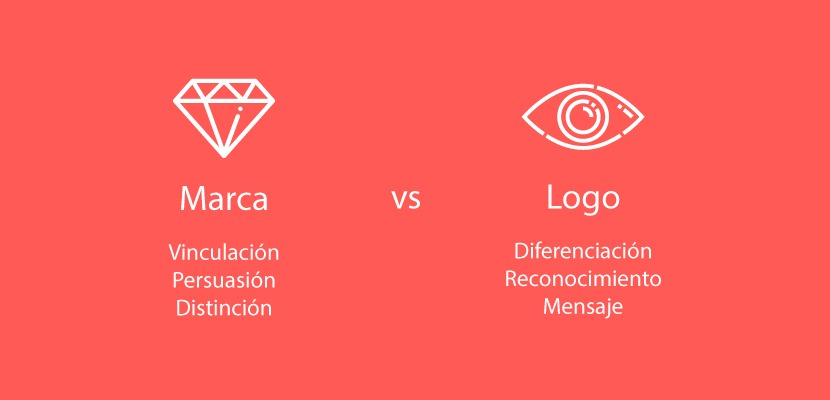
Many people often confuse a brand with a logo, or use the terms interchangeably. This misconception arises from the widespread but incorrect belief that simply having a logo means your brand is established.
At Firstrein, we want to clarify these concepts for you. Understanding the difference, defining them clearly, and implementing them correctly can make a significant difference in the success of your business.
Both the logo and the brand are essential for building a successful business. They must be developed based on professional knowledge to ensure they create the necessary connection with potential customers, leading to strong positioning, recognition, and effective sales of your products or services.
Relying on automated tools to create a logo without proper expertise often leads to poor results.
A good logo must effectively represent your brand, requiring the right handling of variables. Similarly, creating a brand identity that resonates with your target audience demands expert input in design, color psychology, typography, user experience, and marketing. Only then can your brand communicate the right emotions and achieve success in the marketplace.
Let’s explore the fundamental aspects of a brand and a logo, their differences, and their functions.
To differentiate a brand from a logo, you must first understand what constitutes a brand.
Here are three definitions that accurately describe a brand:
1. A brand is the combination of name, term, symbol, design, and other characteristics that identify the products or services of a business and distinguish them from competitors.
2. A brand is the reputation of a business identity in the market—the image or perception customers have of it. A strong brand adds competitive value and drives sales growth.
3. A brand is the intangible sum of a product’s attributes, including its history, name, price, packaging, and reputation.
Creating a brand means establishing an original, unique identity—a distinctive mark that sets your business apart from the competition.
A brand:
• Indicates the company’s origin and what it offers.
• Serves as a fundamental advertising element.
• Reflects corporate values, identity, and philosophy.
• Provides information about the product or service.
• Creates a sense of prestige and trustworthiness.
A logo is a symbol made up of images, letters, or a combination of both, designed to identify a company, institution, organization, or brand, along with the products or services it offers.
A poorly designed logo that lacks creativity, metaphor, or clarity cannot fulfill its function effectively. To ensure a professional logo that performs its role well, it should have the following characteristics:
• Identify, not inform: A logo should represent, not explain.
• Be suggestive, not literal: Avoid overly direct representations.
• Be concise: A logo should synthesize an idea, not delve deeply into details.
• Use graphic metaphors and avoid photos or overly detailed representations.
• Be legible, clear, and easy to interpret.
• Scalable: It must look good in any size or format.
• Applicable to all types of materials.
• Memorable: It should stick in people’s minds.
The primary difference between a brand and a logo lies in their respective functions.
Functions of a Brand:
1. Quality Indicator: A brand helps potential customers recognize the quality of the product.
2. Distinctive Function: Differentiates a product or service from competitors.
3. Advertising Function: Persuades customers to purchase and familiarizes them with the brand.
4. Indicates Origin: Links the product to the company that produces or sells it.
Functions of a Logo:
1. Conveys the brand’s message to its target audience.
2. Enhances brand recognition, making it easy for customers to identify it across designs.
3. Serves as a differentiation tool.
4. Helps consolidate the business in the market.
1 Red Bull: Known as the most popular energy drink brand globally. Its success isn’t due to the taste but its brand image, which associates it with extreme sports, adventure, speed, and excitement.
2 Coca-Cola: A globally recognized brand. Its packaging and branding are so strong that even a small fragment of its label is instantly identifiable. The brand evokes moments of happiness and celebration.
3 Dove: Launched in 1957, Dove is known for its creamy soap and is associated with messages of self-esteem, beauty, and hydration for all women.
1. McDonald’s: The golden arches logo evolved over time, becoming a simplified “M” in 2006—a symbol that’s now iconic worldwide.
2. Ford: First introduced in 1903, Ford’s logo took on its current recognizable form in 1927 with a blue oval and stylized typography.
3. Nike: Created in 1971, Nike’s logo underwent changes until 1995, when the brand dropped the typography, leaving just the iconic swoosh.
Now that you understand the difference between a brand and a logo, as well as their respective functions, it’s clear how essential professional expertise is in building a strong brand identity and an effective logo. Together, they create the foundation for a successful business that communicates the right message to its target audience.
For professional branding and logo design, Firstrein is here to help you stand out in the market and connect with your customers effectively.
Firstrein Design Company LLC Ⓒ — All Rights Reserved.
Top